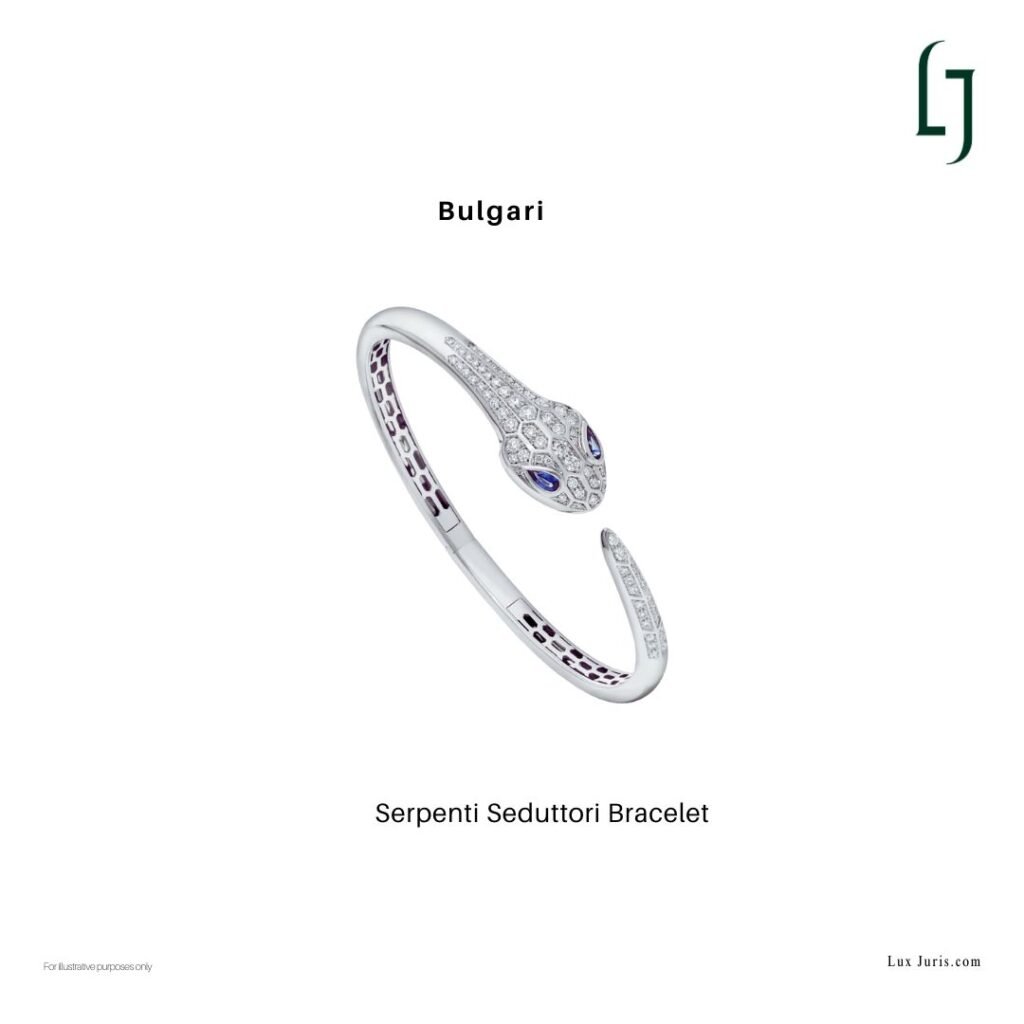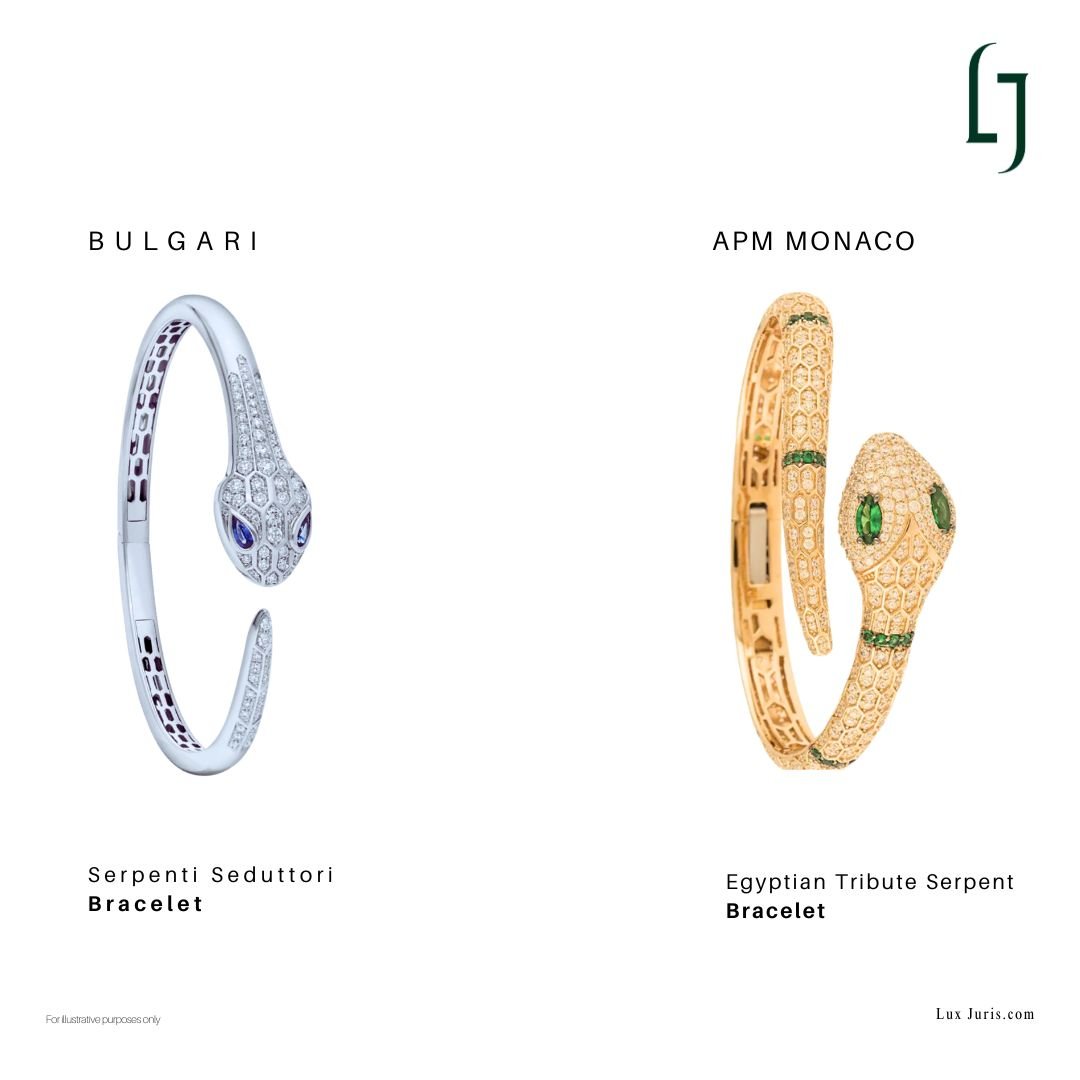In 31 January 2025, the Paris Court of Appeal handed down its ruling in the dispute between Bulgari and APM Monaco. At issue were designs from Bulgari’s Serpenti collection, centred on the stylised serpent head, the coiled form and the pear-cut gemstone eye. Bulgari claimed that APM’s Egyptian Tribute and Archi Noir collections reproduced these elements and brought actions for copyright infringement and parasitism.
The Court confirmed the originality of Bulgari’s Serpenti designs but dismissed the infringement claims. It nevertheless upheld parasitism and ordered APM to cease marketing the disputed pieces in France, awarding Bulgari €130,000 in damages together with contributions to legal costs.
Assessing Originality in Bulgari’s Serpenti Designs
The Court accepted that while the serpent motif is widely used in jewellery, Bulgari’s interpretation was original. The stylised modelling of the serpent’s head, the proportional balance of its parts, and the use of a pear shaped gemstone for the eyes were all deliberate creative choices. Taken together, these features gave the designs a singular appearance reflecting the creator’s personal imprint. The bracelet, ring and earrings from Bulgari’s Serpenti Seduttori line therefore qualified for copyright protection.

The Court made clear that originality does not require innovation or exclusivity. Even a familiar theme can be protected if expressed through specific and individualised artistic decisions.
No Infringement Established
Although Bulgari’s Serpenti designs were recognised as original, the Court found no infringement. It concluded that APM’s pieces did not reproduce the distinctive combination of features that made Bulgari’s works unique. Differences in the serpent head shape, eye placement, and scale configuration created a visually different impression, leading to the dismissal of all infringement claims.
Free Riding on Bulgari’s Market Position
Although the infringement claims were dismissed, the Court upheld Bulgari’s action for parasitism, a form of unfair competition under French law. Parasitism does not depend on infringement or on the existence of formal IP rights. It applies where one party takes unfair advantage of another’s efforts, investment or reputation without incurring comparable creative or commercial risk.
The Court noted Bulgari’s long term investment in the Serpenti Seduttori line, including more than €3.7 million spent on marketing and brand development between 2017 and 2023. APM was found to have launched jewellery that imitated the visual codes of Serpenti, seeking to benefit from the recognisable aesthetic and symbolic value developed by Bulgari without bearing the same creative or financial effort.
The Court considered this a textbook case of free riding
By putting out jewellery that looked similar, APM was found to be taking advantage of the style and reputation Bulgari had built, without making the same creative or financial effort. The Court described this as parasitic behaviour.
Relief and Compensation
The Court ordered APM to cease commercialisation of the identified models in France, with a penalty of €500 per day for up to 180 days. It declined Bulgari’s requests for stock destruction and for publication of the decision.
For parasitism, Bulgari was awarded €130,000 in damages, reflecting moral harm, understood here as the harm to reputation caused by the dilution of its designs. Additional claims for higher sums were refused.
Why the Case Matters
The judgment shows how French courts approach design disputes where common decorative themes are involved. Bulgari’s serpent was recognised as original, but infringement was denied because APM’s models did not reproduce the distinctive combination of features. Liability was instead upheld on parasitism, by launching serpent themed pieces that evoked Serpenti, APM was found to have taken unfair advantage of Bulgari’s reputation and investment.
The decision shows that it is not enough for brands to avoid making exact copies. If they take over the style and market value created by a competitor, they can still be held liable under unfair competition rules.
For design focused brands, the case points to two types of protection, copyright can cover the creative form of a design, while parasitism can protect the reputation and brand value that build up around it.
Last updated August 19 2025
Sources:
